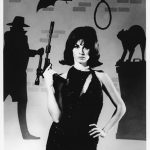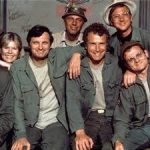Having spent my entire childhood at the feet of my screenwriter mother, I read more TV scripts than books while growing up, as there were piles of them around my mother?s office, and I?d often curl up on the couch and read one after school. I also spent many hours on sound stages and on location watching many of her TV episodes being filmed. Okay, I will confess I liked to sit in Peggy Lipton?s chair during the shooting of Mod Squad, and if we were outside I wore my mirror shades to be in sync with the dynamic threesome I admired (I rarely saw Clarence Williams III ever take his shades off?indoors or outdoors).
I spent many hours wandering in and out of sound stages at Fox, MGM, and other studios where my mother, for a time, had an office. I?d sneak into M.A.S.H. and watch the banter Alan Alda tossed around as he operated on a fake body in the surgery tent, or mosey on over to Battlestar Gallactica. I had fun going on location and even spent a week in San Francisco on the set with Rock Hudson (MacMillan and Wife), since my stepfather was the director of that episode, and got to watch some cool stunts involving cable cars (no, Rock didn?t do his own stunts!).
Influenced By TV and Movies
 I say all this to make the point that growing up in a home that centered around writing and directing for television greatly influenced the way I approach storytelling. Ever since I learned the alphabet, I wrote stories. I even pitched my first script idea at age twelve to the producer of The Girl from U.N.C.L.E. Do you remember that show? (Okay just so you know, Stephanie Powers starred in it, and Ian Fleming was the consultant on the show and suggested the idea, but it only ran twenty-nine episodes before being canceled for low ratings. Maybe if they had bought my idea and wrote that script, it wouldn?t have failed. Hmm, I wonder . . .) I still have my very polite rejection letter?my first of many! It did help that my mother was a staff writer on the show and had ?an in.? However, they didn?t buy my idea. But you can be sure of one thing?even at age twelve I presented my idea to the producer in a way he could easily visualize it as an episode. My young mind was already programmed to write cinematically.
I say all this to make the point that growing up in a home that centered around writing and directing for television greatly influenced the way I approach storytelling. Ever since I learned the alphabet, I wrote stories. I even pitched my first script idea at age twelve to the producer of The Girl from U.N.C.L.E. Do you remember that show? (Okay just so you know, Stephanie Powers starred in it, and Ian Fleming was the consultant on the show and suggested the idea, but it only ran twenty-nine episodes before being canceled for low ratings. Maybe if they had bought my idea and wrote that script, it wouldn?t have failed. Hmm, I wonder . . .) I still have my very polite rejection letter?my first of many! It did help that my mother was a staff writer on the show and had ?an in.? However, they didn?t buy my idea. But you can be sure of one thing?even at age twelve I presented my idea to the producer in a way he could easily visualize it as an episode. My young mind was already programmed to write cinematically.
So when I began writing novels decades later (although I promised my mother I would never be a writer, but that?s another story), it was only natural for me to construct all my scenes visually, the way I might see them play out on film. In fact, I couldn?t imagine writing any differently. I?m not surprised when I continually get comments from readers like, ?I could so picture this book as a movie? or ?this novel would make a great movie.? I believe they say these things not so much because they think my books are brilliant but because I write cinematically. Every scene is structured either consciously or unconsciously with a series of camera shots, so the reader will see the scene play out the way I see it.
I?m very familiar with the camera shots used?and and as I mentioned before, you really are too. If you?ve watched a few TV shows or seen a few movies, you?re already familiar with what I?m going to share with you. What you don?t yet know, possibly, is how to transcribe what you see on the screen to the words on your pages. So I?m going to deconstruct movie technique by examining the camera shots one by one, and showing examples in novels in which the writer has effectively used a particular camera angle (or multiple angles) to create a supercharged scene. And later in the year, we?ll look at other cinematic techniques that involve shapes, colors, framing, sound, and other effects.
Varieties of Camera Angles for Specific Effects
 Screenplays are structured through the use of camera direction, which becomes all-important to telling the story. The choice of camera angles within a scene affects the mood, focus, and emphasis of the story being told, and directs the viewer to pay attention to particular elements unfolding. The right camera angle will give the best impact: you wouldn?t film a huge explosion using a Close-up but rather a Long Shot encompassing the wide scope of action. Writers, too, should think about not just the character POV (point of view) of a scene but the camera angles. Don?t leave it up to the reader to figure out what is important to notice. Put on your director?s hat and think what shots will focus on what?s important. By using these filming techniques to point your reader?s attention where you want it to go, you will get the results you want.
Screenplays are structured through the use of camera direction, which becomes all-important to telling the story. The choice of camera angles within a scene affects the mood, focus, and emphasis of the story being told, and directs the viewer to pay attention to particular elements unfolding. The right camera angle will give the best impact: you wouldn?t film a huge explosion using a Close-up but rather a Long Shot encompassing the wide scope of action. Writers, too, should think about not just the character POV (point of view) of a scene but the camera angles. Don?t leave it up to the reader to figure out what is important to notice. Put on your director?s hat and think what shots will focus on what?s important. By using these filming techniques to point your reader?s attention where you want it to go, you will get the results you want.
This week, go through some scenes in your current novel and think about how you would shoot them. Note places where you might need to get up close to see some important small details. Find other places where you would want to give a more panoramic or faraway view of what?s unfolding. Try to start thinking in ways you might shoot your scene rather than ?tell? it. You might even want to print out your pages and highlight all the passages that are narrative and telling rather than showing, then consider where you might position a camera to film the action.
Source: http://www.livewritethrive.com/2013/01/23/its-all-about-the-angle/
dyngus day indonesia quake stephen strasburg shabazz legion baby found alive in morgue rockies
কোন মন্তব্য নেই:
একটি মন্তব্য পোস্ট করুন